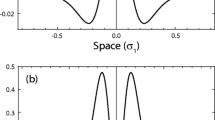Abstract
We present a parsimonious model of brightness induction which can account for various brightness illusions of both brightness-contrast and brightness-assimilation types. Our model is based on a difference of difference-of-Gaussian filter and a two-pass model of attentive vision based on the parallel channels in the central visual pathway. It overcomes some of the problems that could not be addressed by the well-known oriented difference of Gaussian model like those associated with Mach band and checkerboard illusions. This model attempts to provide insight to the mechanism of attention in brightness perception through the two major complimentary visual channels, viz. the magnocellular and the parvocellular.














Similar content being viewed by others
References
Bar M (2003) A cortical mechanism for triggering top-down facilitation in visual object recognition. J Cogn Neurosci 15:600–609
Blakeslee B, McCourt ME (1999) A multiscale spatial filtering account of the White effect, simultaneous brightness contrast and grating induction. Vis Res 39:4361–4377
Bullier J (2001) Integrated model of visual processing. Brain Res Rev 36:96–107
De Valois RL, De Valois KK (1988) Spatial vision. Oxford University Press, New York
De Valois RL, Cottaris NP, Mahon LE, Elfar SD, Wilson JA (2000) Spatial and temporal receptive fields of geniculate and cortical cells and directional selectivity. Vis Res 40:3685–3702
Ferrera VP, Nealey TA, Maunsell JRH (1992) Mixed parvocellular and mangocellular geniculate signals in visual area V4. Nature 358:756–758
Foley JM, McCourt ME (1985) Visual grating induction. J Opt Soc Am A 2(7):1220–1230
Ghosh K (2012) A possible role and basis of visual pathway selection in brightness induction. Seeing Perceiving 25:179–212
Ghosh K, Pal SK (2010) Some insights into brightness perception of images in the light of a new computational model of figure-ground segregation. IEEE Trans SMC-A 40(4):758–766
Ghosh K, Sarkar S, Bhaumik K (2005a) A possible mechanism of zero-crossing detection using the concept of extended classical receptive field model of retinal ganglion cells. Biol Cybern 93:1–5
Ghosh K, Sarkar S, Bhaumik K (2005b). Low-level brightness-contrast illusions and non classical receptive field of mammalian retina. In: Intelligent sensing and information processing, 2005. Proceedings of 2005 international conference on, pp 529–534
Ghosh K, Sarkar S, Bhaumik K (2006) A possible explanation of the low-level brightness–contrast illusions in the light of an extended classical receptive field model of retinal ganglion cells. Biol Cybern 94:89–96
Heinemann EG (1955) Simultaneous brightness induction as a function of inducing and testfield luminances. J Exp Psychol 50:89–96
Howe PDL (2001) A comment on the Anderson (1997), the Todorovic (1997), and the Ross and Pessoa (2000) explanations of White’s effect. Perception 30:1023–1026
Hubel DH, Wiesel TN (1959) Receptive fields of single neurones in the cat’s striate cortex. J Physiol 148(3):574–591
Kandel ER, Schwartz JH, Jessell TM (eds) (2000) Principles of neural science. McGraw-Hill, New York
Kaplan E, Shapley RM (1982) X and Y cells in the lateral geniculate nucleus of macaque monkeys. J Physiol 330:125–143
Kingdom FAA (2011) Lightness, brightness and transparency: a quarter century of new ideas, captivating demonstrations and unrelenting controversy. Vis Res 51:652–673
Kuffler SW (1952) Neurons in the retina: organization, inhibition and excitation problems. Cold Spring Harb Symp Quant Biol 17:281–292
Kveraga K, Boshyan J, Bar M (2007) Magnocellular projections as the trigger of top-down facilitation in recognition. J Neurosci 27:13232–13240
Marr D (1982) Vision: a computational investigation into the human representation and processing of visual information. W. H. Freeman and Company, New York
Maunsell JH, Nealey TA, DePriest DD (1990) Magnocellular and parvocellular contributions to responses in the middle temporal visual area (MT) of the macaque monkey. J Neurosci 10:3323–3334
Merigan WH, Maunsell JRH (1993) How parallel are the primate visual pathways? Annu Rev Neurosci 16:369–402
Nowak LG, Munk MHJ, Girard P, Bullier J (1995) Visual latencies in areas V1 and V2 of the macaque monkey. Vis Neurosci 12:371–384
Robinson AE, Hammon PS, de Sa VR (2007a) Explaining brightness illusions using spatial filtering and local response normalization. Vis Res 47:1631–1644
Robinson AE, Hammon PS, de Sa VR (2007b) A filtering model of brightness perception using frequency-specific locally-normalized oriented difference-of-Gaussians (FLODOG). Vision Sciences Society, Sarasota
Rodieck RW, Stone J (1965) Analysis of receptive fields of cat retinal ganglion cells (1965). J Neurophysiol 28:833–849
Schiller PH, Malpeli JG (1978) Functional specificity of lateral geniculate nucleus laminae of the rhesus monkey. J Neurophysiol 41:788–797
Shou T, Wang W, Yu H (2000) Orientation biased extended surround of the receptive field of cat retinal ganglion cells. Neuroscience 98:207–212
Solomon SG, White AJR, Martin PR (2002) Extraclassical receptive field properties of parvocellular, magnocellular, and koniocellular cells in the primate lateral geniculate nucleus. J Neurosci 22:338–349
Spehar B, Gilchrist AL, Arend LE (1997) Qualitative boundaries critical in White’s effect and square-wave brightness induction: a reply to kingdom, et al. Vis Res 37(8):1044–1047
von Békésy G (1967) Mach band type lateral inhibition in different sense organs. J Gen Physiol 50:519–532
von Békésy G (1968) Brightness distribution across the Mach bands measured with flicker photometry, and the linearity of sensory nervous interaction. J Opt Soc Am 58:1–8
White M (1979) A new effect of pattern on perceived lightness. Perception 8:413–416
Acknowledgements
We express our sincere gratitude to Alan Robinson for providing us with the code of his implementation of the ODOG filter (Robinson et al. 2007a, b) whose outputs have been shown above, and with which they compared their own FLODOG filter. Ashish Bakshi would like to thank the Council of Scientific and Industrial Research (CSIR) for providing financial support to him which enabled him to perform this work.
Author information
Authors and Affiliations
Corresponding author
Additional information
Communicated by J. Leo van Hemmen.
Rights and permissions
About this article
Cite this article
Bakshi, A., Ghosh, K. A parsimonious model of brightness induction. Biol Cybern 112, 237–251 (2018). https://doi.org/10.1007/s00422-018-0747-0
Received:
Accepted:
Published:
Issue Date:
DOI: https://doi.org/10.1007/s00422-018-0747-0




